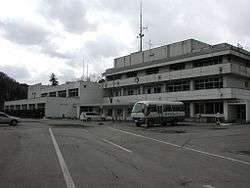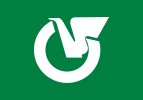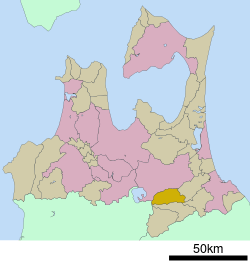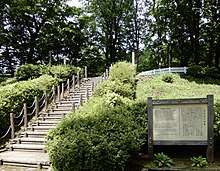Shingō, Aomori
Shingō (新郷村, Shingō-mura) is a village located in Aomori Prefecture, Japan. As of 31 March 2020, the village has an estimated population of 2,408 in 922 households[1] and a population density of 16 persons per km² (42 people per square mile). The total area of the village is 150.77 square kilometres (58.21 sq mi).[2]
Shingō 新郷村 | |
|---|---|
Village | |
 Shingō Village Office | |
 Flag  Seal | |
 Location of Shingō in Aomori Prefecture | |
 Shingō | |
| Coordinates: 40°27′49.19″N 141°10′27.53″E | |
| Country | Japan |
| Region | Tōhoku |
| Prefecture | Aomori |
| District | Sannohe |
| Area | |
| • Total | 150.77 km2 (58.21 sq mi) |
| Population (March 2020) | |
| • Total | 2,408 |
| • Density | 16/km2 (41/sq mi) |
| Time zone | UTC+9 (Japan Standard Time) |
| - Tree | Aesculus |
| - Flower | Asian skunk cabbage |
| Phone number | 0178-78-2111 |
| Address | 039-0801 |
| Website | Official website |
Geography
Shingō is in south-central Aomori Prefecture, east of Lake Towada. The western edge of the village borders Akita Prefecture. Much of the village is mountainous with the outer ring mountains of Lake Towada, including Mt. Okomagatake (1,144 meters) and Mt. Toraidake (1,159 m). The village area extends along National Route 454, which connects Hachinohe City, Aomori Prefecture and Lake Towada.
Neighboring municipalities
Climate
The village has a cold Humid continental climate characterized by cool short summers and long cold winters with very heavy snowfall (Köppen climate classification Dfa). The average annual temperature in Shingō is 8.7 °C (47 °F). The average annual rainfall is 1342 mm (53 in.), with September as the wettest month. The temperatures are highest on average in August, at around 22.2 °C (72 °F), and lowest in January, at around -3.7 °C (25 °F).[3]
Demographics
Per Japanese census data,[4] the population of Shingō has declined steadily over the past 70 years.
| Historical population | ||
|---|---|---|
| Year | Pop. | ±% |
| 1950 | 6,411 | — |
| 1960 | 6,409 | −0.0% |
| 1970 | 4,754 | −25.8% |
| 1980 | 4,332 | −8.9% |
| 1990 | 3,724 | −14.0% |
| 2000 | 3,343 | −10.2% |
| 2010 | 2,851 | −14.7% |
History
The area around Shingō was controlled by the Nambu clan of Morioka Domain during the Edo period. During the post-Meiji restoration establishment of the modern municipalities system on 1 April 1889, Herai Village and neighboring Nozawa Village were formed. On July 29, 1955 the western portion of Nozawa Village merged into Herai, which was then renamed Shingō.
Government
Shingō has a mayor-council form of government with a directly elected mayor and a unicameral village council of eight members. Shingō is part of Sannohe District which contributes three members to the Aomori Prefectural Assembly. In terms of national politics, the town is part of Aomori 2nd district of the lower house of the Diet of Japan.
Education
Shingō has two public elementary schools and two public middle schools operated by the village government. The village does not have a high school.
Economy
The economy of Shingō is heavily dependent on agriculture. Notable crops include edible chrysanthemum, Japanese yam and tobacco. Traditionally a horse breeding area, Shingō is also known for its cattle ranches.
Local attractions

Shingō village is the location of what is purported to be the last resting place of Jesus, located in the "Tomb of Jesus" (Kirisuto no haka), and the residence of Jesus' last descendants, the family of Sajiro Sawaguchi.[5] According to the Sawaguchi family's claims, Jesus Christ did not die on the cross at Golgotha. Instead his brother, Isukiri,[6] took his place on the cross, while Jesus fled across Siberia to Mutsu Province, in northern Japan. Once in Japan, he changed his name to Torai Tora Daitenku, became a rice farmer, married a twenty-year old Japanese woman named Miyuko, and raised three daughters near what is now Shingō. While in Japan, it is asserted that he traveled, learned, and eventually died at the age of 106. His body was exposed on a hilltop for four years. According to the customs of the time, Jesus' bones were collected, bundled, and buried in the mound purported to be the grave of Jesus Christ.[7][8]
Another mound near the alleged grave of Jesus is said to contain an ear of the brother of Jesus and a lock of hair from Mary, the mother of Jesus, the only relics of his family Jesus could carry when he fled Judaea.[9] The claims started in 1933 after the discovery of supposed "ancient Hebrew documents detailing Jesus' life and death in Japan" [10] that was supposedly the testament of Jesus. These documents are referred to as the Takeuchi Documents which are said to be ancient documents passed down through the family of Takeuchi Kiyomaro, the founder of a religious movement called Amatsukyo. The documents were allegedly seized by the Japanese authorities and taken to Tokyo shortly before World War II during a crackdown on the Amatsukyo religion in 1935, and have not been seen since.[11][12]
References
- Shingō Village official statistics
- 詳細データ 青森県青森県新郷村. 市町村の姿 グラフと統計でみる農林水産業 (in Japanese). Ministry of Agriculture, Forestry and Fisheries. 2016. Retrieved 13 July 2017.
- Shingō climate data
- Shingō population statistics
- "From Japanese text of the sign included in this article".
- "Japan Travel: Jesus in Japan". Metropolis. Archived from the original on 2006-08-25. Retrieved 2006-12-13.
- "The Japanese Jesus Trail". BBC. September 9, 2006. Retrieved 2006-12-13.
- "Land of the Rising Son". Fortean Times. May 1998. Archived from the original on 2007-03-10. Retrieved 2006-12-13.
- Bird, Winifred, "Behold! Christ's grave in Shingo, Aomori Prefecture", Japan Times, 25 December 2011, p. 10.
- "The Japanese Jesus Trail". BBC. September 9, 2006. Retrieved 2006-12-13.
- "Land of the Rising Son". Fortean Times. May 1998. Archived from the original on 2007-03-10. Retrieved 2006-12-13.
- Okamoto, Ryosuke (2019). Pilgrimages in the Secular Age: From El Camino to Anime. Tokyo: Japan Publishing Industry Foundation for Culture. p. 109. ISBN 978-4-86658-064-7. Retrieved 29 May 2019.
External links
![]()
- Official Website (in Japanese)
| Wikivoyage has a travel guide for Shingo. |